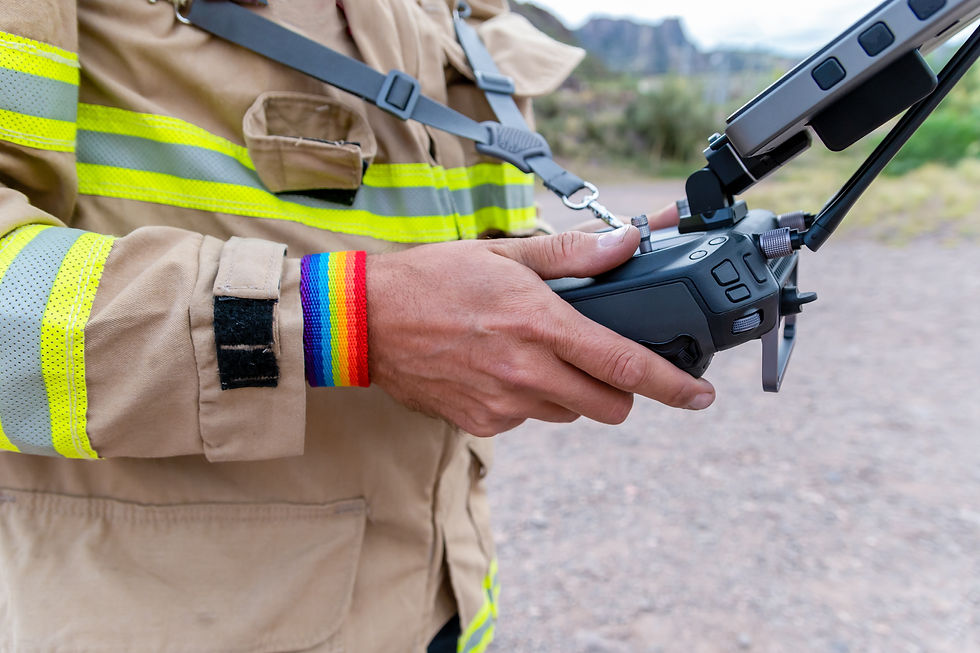The Latest Trends in First Responder Equipment
- wguilliouma
- Jun 13, 2024
- 4 min read
First responders—police officers, firefighters, paramedics, and other emergency personnel—are at the frontline of emergency situations, ensuring public safety and responding to crises. The equipment they use is critical for their safety and effectiveness. Recent technological advancements and innovations have significantly enhanced the capabilities of first responder equipment. Here’s a look at the latest trends shaping the future of first responder gear.

1. Wearable Technology
Wearable technology is revolutionizing the way first responders operate in the field. These devices enhance situational awareness, communication, and personal safety.
Smart Helmets: Equipped with augmented reality (AR), smart helmets provide firefighters with real-time information about the environment, such as temperature, oxygen levels, and potential hazards. These helmets can also display building layouts and highlight safe exit routes.
Body Cameras: For police officers, body cameras have become an essential tool for transparency and accountability. The latest models offer high-definition video, automatic activation, and real-time streaming capabilities, ensuring accurate documentation of incidents.
Health Monitoring Wearables: Paramedics and firefighters can now use wearables that monitor vital signs like heart rate, body temperature, and hydration levels. These devices can alert users to potential health issues before they become critical, ensuring their well-being during high-stress operations.
2. Drones and Robotics
Drones and robotics are increasingly being deployed in various emergency response scenarios, providing valuable support and reducing human risk.
Search and Rescue Drones: Equipped with thermal imaging cameras and GPS, drones can quickly locate missing persons in challenging terrains. They provide real-time aerial views, allowing responders to plan and execute rescue operations more effectively.
Firefighting Robots: In hazardous environments where human firefighters cannot safely operate, firefighting robots can be deployed. These robots can navigate through smoke-filled areas, locate the source of the fire, and extinguish flames using advanced suppression systems.
Bomb Disposal Robots: For police and bomb squads, robots equipped with precision tools and cameras are crucial for safely disarming explosive devices, reducing the risk to human life.
3. Advanced Communication Systems
Effective communication is paramount in emergency situations. The latest advancements in communication technology ensure that first responders can stay connected, even in the most challenging conditions.
Next-Generation Radios: Modern radios offer enhanced features such as GPS tracking, encrypted communication, and interoperability across different agencies. These radios ensure that first responders can communicate seamlessly, improving coordination during multi-agency operations.
Push-to-Talk (PTT) Apps: PTT applications on smartphones enable instant voice communication over cellular networks. These apps provide a reliable alternative to traditional radio systems, especially in urban areas with strong mobile network coverage.
Satellite Communication: In remote or disaster-stricken areas where traditional communication infrastructure is compromised, satellite phones and portable satellite communication units provide a reliable means of staying connected.
4. Personal Protective Equipment (PPE)
Advancements in PPE have significantly improved the safety and comfort of first responders, enabling them to perform their duties more effectively.
Fire-Resistant Clothing: Modern fire-resistant fabrics are lighter, more breathable, and provide better protection against heat and flames. These materials enhance the mobility and endurance of firefighters during prolonged operations.
Ballistic Protection: For police officers and SWAT teams, the latest body armor designs offer improved ballistic protection while being lightweight and flexible. New materials like graphene and Kevlar ensure maximum safety without compromising on mobility.
Hazmat Suits: Advances in hazmat suit technology have led to more comfortable and durable designs that provide better protection against chemical, biological, radiological, and nuclear (CBRN) threats. These suits are essential for paramedics and hazardous materials response teams operating in contaminated environments.
5. Medical Equipment and Supplies
For paramedics and emergency medical technicians (EMTs), having access to cutting-edge medical equipment can mean the difference between life and death.
Portable Ultrasound Devices: Compact and lightweight ultrasound devices allow paramedics to perform critical diagnostics in the field, such as detecting internal bleeding or assessing the severity of injuries. These devices provide valuable information that can guide treatment decisions before reaching the hospital.
Automated External Defibrillators (AEDs): Modern AEDs are more user-friendly, providing clear voice instructions and automated analysis of the patient’s heart rhythm. These devices increase the chances of survival for cardiac arrest victims by enabling prompt and effective intervention.
Telemedicine: Telemedicine platforms enable paramedics to consult with doctors and specialists in real-time, providing expert guidance during critical situations. This technology ensures that patients receive the best possible care, even in the pre-hospital setting.
6. Data Analytics and Artificial Intelligence (AI)
The integration of data analytics and AI is transforming the way first responders operate, providing them with actionable insights and predictive capabilities.
Predictive Policing: AI algorithms analyze historical crime data to identify patterns and predict potential hotspots of criminal activity. This information allows police departments to allocate resources more effectively and prevent crimes before they occur.
Incident Management Systems: Advanced incident management platforms aggregate data from multiple sources, providing a comprehensive view of ongoing operations. These systems enable better decision-making and coordination among different agencies.
Health and Safety Analytics: Wearable devices and sensors collect data on the physical condition of first responders. AI-driven analytics can identify trends and potential health risks, allowing for proactive measures to ensure their well-being.
Conclusion
The latest trends in first responder equipment are driven by the need for enhanced safety, efficiency, and effectiveness in emergency situations. Wearable technology, drones, advanced communication systems, improved PPE, state-of-the-art medical equipment, and AI-driven analytics are all playing crucial roles in shaping the future of emergency response. As technology continues to evolve, first responders will be better equipped to face the challenges of their demanding roles, ultimately saving more lives and protecting communities more effectively.








Comments